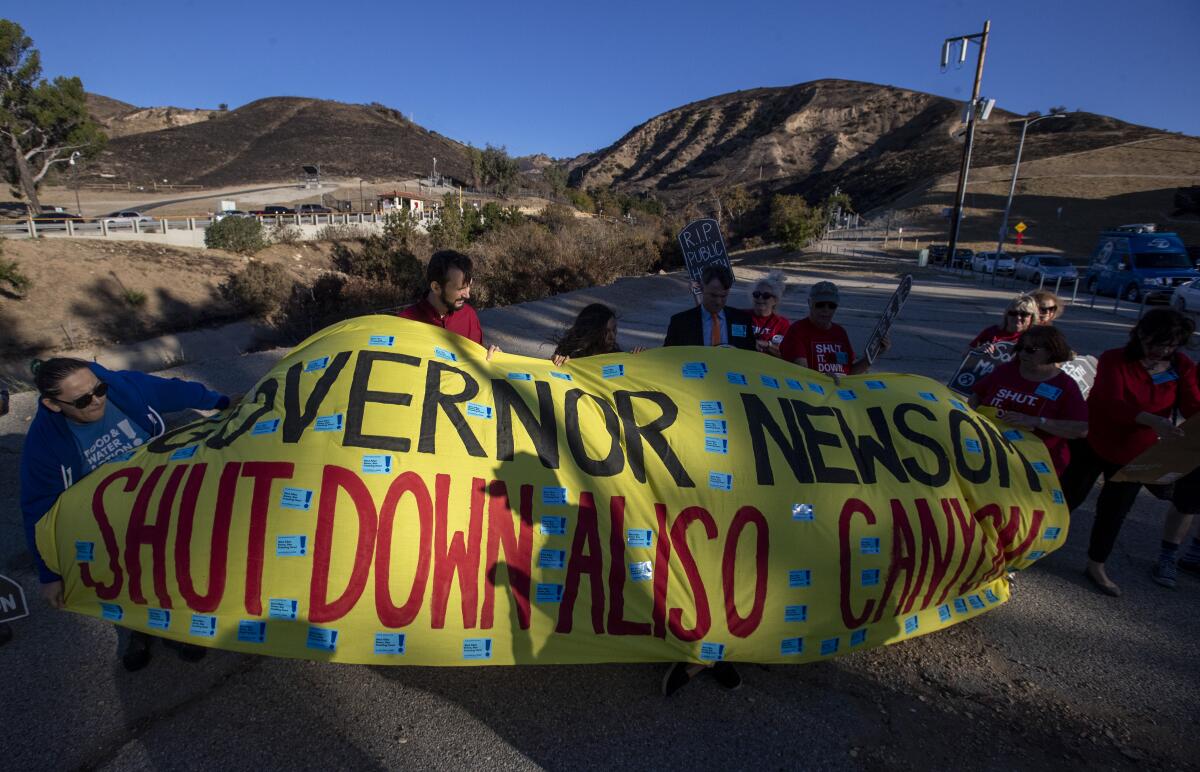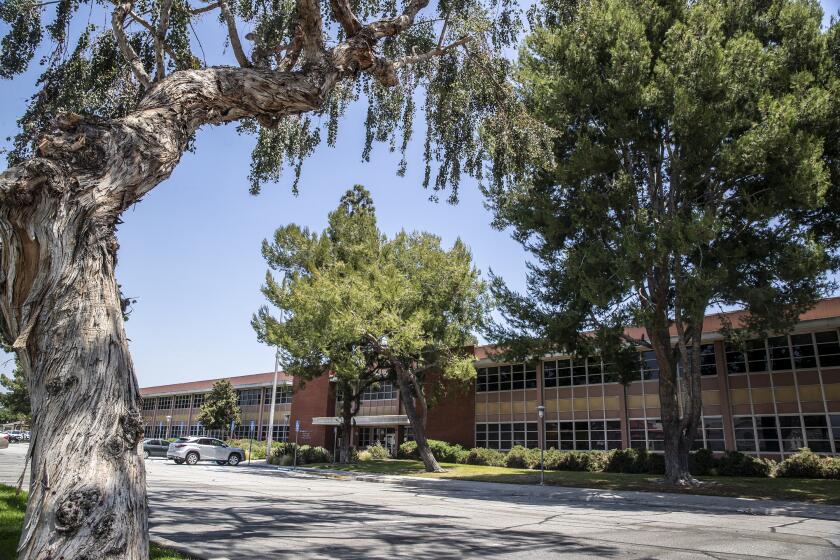Plan to shutter Aliso Canyon gas facility isn’t moving fast enough for community activists

- Share via
Good morning, and welcome to the Essential California newsletter. It’s Sunday. I’m your host, Andrew J. Campa. Here’s what you need to know to start your weekend:
- A new plan could eventually shutter the Aliso Canyon gas facility.
- Adam Schiff will soon have a new title: Freshman.
- California removes slur targeting Indigenous women from place names.
- And here’s today’s e-newspaper.
Sign up for Essential California
The most important California stories and recommendations in your inbox every morning.
You may occasionally receive promotional content from the Los Angeles Times.
Aliso Canyon could shut down in the not-too-distant future
Nearly 10 years ago, the Aliso Canyon gas storage leak in Porter Ranch pumped 100,000 tons of methane and other chemicals into the air over a four-month period.
Roughly 8,000 families temporarily evacuated their homes within days after some reported headaches, nosebleeds, nausea and other illnesses. It was the largest natural gas leak in American history.
Around that time, local concern surrounding the leak, which took place between late 2015 and early 2016, galvanized a question repeated often by community activists: “When will Aliso Canyon close?”
On Wednesday, the California Public Utilities Commission provided some clues to that riddle, unveiling a proposal that could potentially shutter the Aliso Canyon gas storage field, operated by SoCalGas, in the coming years.
Local activists and politicians, however, were quick to say that the plan doesn’t provide a fast or clear enough timeline to shut down the site.
What is the plan?
My colleague Clara Harter and I reviewed the plan.
Southern California’s demand for natural gas is expected to lessen in the coming years as the state increases its use of renewable energy sources, according to the CPUC.
The goal is to get the region to a point where peak demand can be served without Aliso Canyon. But it could be years before that happens.
According to the plan, the CPUC would initiate proceedings to review and potentially close the facility only when the peak demand forecast for a date two years in the future is below 4,121 million metric cubic feet per day.
Peak demand, currently forecast at 4,618 million metric cubic feet per day, is expected to drop to 4,197 million in 2030, according to the CPUC.
“We continue to review the decision but share the commission’s view that Aliso Canyon is a necessary part of California’s energy infrastructure today,” SoCalGas spokesperson Chris Gilbride said in a statement Friday.
Damage caused by the leak, and the changes since
SoCalGas has a contentious relationship with the Porter Ranch community and has faced lawsuits alleging it knew about issues at the site and failed to address them.
Firefighters also filed suits alleging that the company failed to inform them about the extent of their exposure to harmful chemicals when responding to the leak.
In 2016, SoCalGas pleaded no contest to a misdemeanor count of failing to immediately report the leak. In 2021, it agreed to pay up to $1.8 billion to settle the claims of more than 35,000 victims.
Since then, the company has implemented a number of safety improvements at Aliso Canyon, including an infrared methane monitoring system, safety tests on all 114 wells, employees who operate new leak-detection systems 24 hours a day, new reporting policies for releases of hazardous materials and more safety training.
Aliso Canyon can’t close fast enough for community activists and politicians
Several politicians who represent Porter Ranch and support closing Aliso Canyon said they are frustrated by what they see as a lack of urgency and clarity around when the site will realistically cease operation.
“The optimism part is that there is a path to shut it down,” Assemblymember Pilar Schiavo (D-Chatsworth) said in a phone interview. “The skeptical side, however, is there really is no timeline. It’s unclear.”
L.A. County Supervisor Lindsey Horvath called the draft decision “unacceptable,” saying in a statement that it “fails to prioritize the health and well-being of a community that bore the brunt of the worst natural gas leak in American history.”
This sentiment was echoed by Matt Pakucko, president of the advocacy group Save Porter Ranch, which has fought to close the storage facility since shortly after the leak.
“This isn’t an energy issue, it’s a health issue,” Pakucko said.
Why is Aliso Canyon still operating?
In 2023, Newsom’s appointees to the CPUC voted 5-0 to allow SoCalGas to store far more fuel at the site to help bring down gas rates.
Rising natural gas costs were a big issue last winter, when SoCalGas said the average bill for each of its 21.8 million customers in January 2023 was about $300 — more than twice the previous year.
The company blamed unusually cold winter weather and constraints on pipelines and gas storage facilities for the spike in prices. Others blamed the company for mismanaging its inventory and increasing exports to Europe to take advantage of high prices due to the Russia-Ukraine war.
Next steps
The closure plan will be discussed at the commission’s Dec. 19 meeting in San Francisco. The public can attend in person or virtually.
The week’s biggest stories
The 2024 election and its aftermath
- After high-profile clashes with Trump, Adam Schiff will soon have a new title: Freshman.
- Why the RFK Jr. nomination sets off alarms among many public health specialists.
- Trump’s early moves send strong signals about what to expect.
- Trump’s Cabinet picks will test Senate independence.
- Here are the last actions the Biden administration will take before Trump takes over the White House.
- Why LA28 officials are not worried about Trump’s support for the Olympics.
Water and environmental issues
- Wildfire retardant is laden with toxic metals, USC study finds.
- A century after the Owens Valley aqueduct protest, an event marks a tense time in L.A. water history.
- The expansion of the San Luis Reservoir is set to boost California’s water-storing capacity.
Crime, courts and policing
- Crypto ‘godfather’ of Bel-Air: Probe widens into L.A. deputies’ alleged links to mogul.
- Orange County man receives life sentence for hate-motivated murder.
- Man arrested in connection with suspicious bag that prompted shutdown of Torrance courthouse.
- She heard knocking beneath the floor of her home for weeks. Police made a disturbing discovery.
More big stories
- How much is one Paul Skenes card worth? Pirates offer 30 years of prime season tickets.
- Jenny Mollen finds out she has lice — in the middle of a 5-hour flight.
- Southland to see cooler temps, rain, snow this weekend, but riskier fire weather looms.
- Josh Brolin’s memoir presents a series of vignettes starring the actor as himself.
Get unlimited access to the Los Angeles Times. Subscribe here.
Column One
Column One is The Times’ home for narrative and longform journalism. Here’s a great piece from this week:
At the end of her first summer camp, 11-year-old Naíma Arteaga was nervous about the final group activity she was required to do: sing in a rock band and perform onstage in front of a large audience. The task sounds ludicrous, but Arteaga wasn’t at any ordinary camp — she was at Chicxs Rockerxs South East Los Angeles (pronounced cheek-ecks roh-kerr-ecks), where girls, trans and gender-fluid youth learn to play instruments, create bands with one another, write original songs and perform live for a crowd during a showcase, all in just the span of a week.
More great reads
- Column: ‘The Onion buys Infowars’ is not the craziest headline this week.
- Commentary: When the Mountain fire hit close to home, this community banded together.
- A 150-million-year journey from the Jurassic to Exposition Park.
How can we make this newsletter more useful? Send comments to essentialcalifornia@latimes.com.
For your weekend

Going out
- 🌌 “Big Bang Theory” star Kaley Cuoco takes us for a ride on her ideal Los Angeles Sunday Funday.
- 🔔 From Amtrak trains to church mission bells and barbecue, charming San Juan Capistrano is worth a visit.
- 👟 Walking in LA: Here are our 11 essential routes through Los Angeles.
Staying in
- 🏜️ Find your way back into the Dune universe as the prequel “Dune: Prophecy” debuts on HBO.
- 📖 The book “Golden Years: How Americans Invented and Reinvented Old Age” investigates life’s grand chapter.
- 🧑🍳 Chef Rashida Holmes of Bridgetown Roi shares her macaroni and cheese pie recipe, one of her restaurant’s best-selling items.
- ✏️ Get our free daily crossword puzzle, Sudoku, word search and arcade games.
L.A. Affairs
Get wrapped up in tantalizing stories about dating, relationships and marriage.
Their online profiles could not have been more dissimilar. She was recovering from an excruciating divorce and signed up on the advice of her writer friends (“It’s great character material!”). Her profile was just a photo of an eye and a passage from a novel. He posted a straightforward photo with a complete description of who he was and who he wanted to meet. Lucky for her, he’s into literature.
Have a great weekend, from the Essential California team
Andrew J. Campa, reporter
Cindy Chang, City Editor
Check our top stories, topics and the latest articles on latimes.com.
Sign up for Essential California
The most important California stories and recommendations in your inbox every morning.
You may occasionally receive promotional content from the Los Angeles Times.







